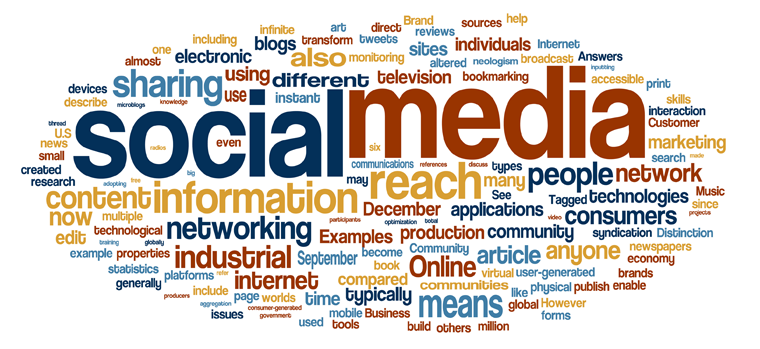//
May 4, 2016
Basic Marketing Terms Clients Need to Know for Success
You’ve made an appointment to talk with a boutique marketing firm about your marketing needs, but you want to be prepared when they start throwing around industry terms.
Having an understanding of these basic marketing terms will make it easier to determine what services are best for your company.
DIFFERENT MARKETING TYPES
Thirty years ago, there was outbound marketing. Period. Nowadays, there are many different types of marketing approaches. It’s helpful to know the basic differences.

Word-splatter infographic via
1. OUTBOUND
Marketing that pushes your message out to a broad audience, also known as “disruptive” marketing. Methods include advertising, direct mail, trade shows and telemarketing.
2. INBOUND
Opposite of outbound, this marketing strategy draws customers in closer to your brand by offering relevant information they are seeking via blogging, social media, e-marketing and search engine optimization.
3. CONTENT
The distribution of valuable, reliable, high quality content (words, photos, videos, etc.) on a consistent basis to attract and retain a specifically-targeted customer. Inbound marketing falls under the umbrella of content marketing.
4. DIGITAL
Marketing of products and services through digital technologies such as the internet, mobile phones and display advertising. This can encompass
5. SOCIAL MEDIA
Gaining website traffic and attention through social media sites by creating content that encourages recipients to share it across their social networks.
These types of marketing just scratch the surface. Click to see an another comprehensive list.
DIFFERENT TERMINOLOGY
Different terminology is used for the different types of marketing. To help you decipher marketing “code words,” below are samples from each category:
1. OUTBOUND
- Mailing list — Compiled lists of addresses based on specific criteria to target a desired audience.
- Media buy — Whether print or online, this process includes identifying where ads will be placed, how large the ad is, how many days the ad will run and negotiating pricing depending on budget.
- Campaign — A campaign involved multiple advertisements that share the same idea of theme.
2. INBOUND
- SEO — Search engine optimization helps online search engines (Google, Bing, Yahoo), and more importantly, people making those web searches (queries), find your website.
- Marketing automation — With all the parts and pieces involved with a full inbound marketing strategy, automating all those parts to seamlessly integrate is necessary to be effective. There are software platforms available to tie all elements of inbound marketing into one nice, neat bow.
- Lead magnet — Also referred to as premium or gated content, lead magnets are valuable information offered to prospective “leads” (customers) in exchange for that lead’s contact information. The information gained is valuable for follow-up with these respondents.
3. CONTENT
- Blog — Blogs have become instrumental to overall content marketing strategies. Posting blogs to your website (informational, educational, interesting, easy-to-read blogs!) help drive traffic to your website with opportunities for people to share via social media.
- Conversion rate — Data is examined through your automation platform to obtain a measurement of how successful a specific piece of marketing content is. A sample conversion rate: 10 people out of 100 were “converted” from casual visitors to your website, to “potential leads” by filling out a form to receive a particular piece of content.
- eBook — A digitally published book, this type of content is often used as a lead magnet.
4. DIGITAL
- Banner ad — These static or animated ads are placed within web pages, most often containing a link back to the promoter’s website.
- Click-Through Rate (CTR) — This data is the percentage of people who click on a given link after seeing it on a web page or in an email.
- Pay-Per-Click (PPC) — A marketing strategy where payment is made to have a digital ad placed directly above, beside or below search-engine listings. Placement of these ads is determined by “per-click” bidding.
5. SOCIAL MEDIA
- Thread — The conversation “trail” within a social media platform, starting with the original post and showing all follow-on comments and conversation relative to that post.
- Viral — In the social media world, something is referred to as “going viral” when posted content rapidly spreads throughout that network (and beyond!).
- Hashtag — Originally introduced on the social media site Twitter, the hashtag symbol (#) is used to make it easier to find messages and/or images that have been sent relative to a specific theme of subject. For example, typing in a search for “#olympics2016” will return posts that relate to that specific subject.
As mentioned earlier, we have just scratched the surface when it comes to understanding basic marketing terms. It’s the job of a to interpret this language into a marketing plan that’s clear, understandable and fits your unique needs.







